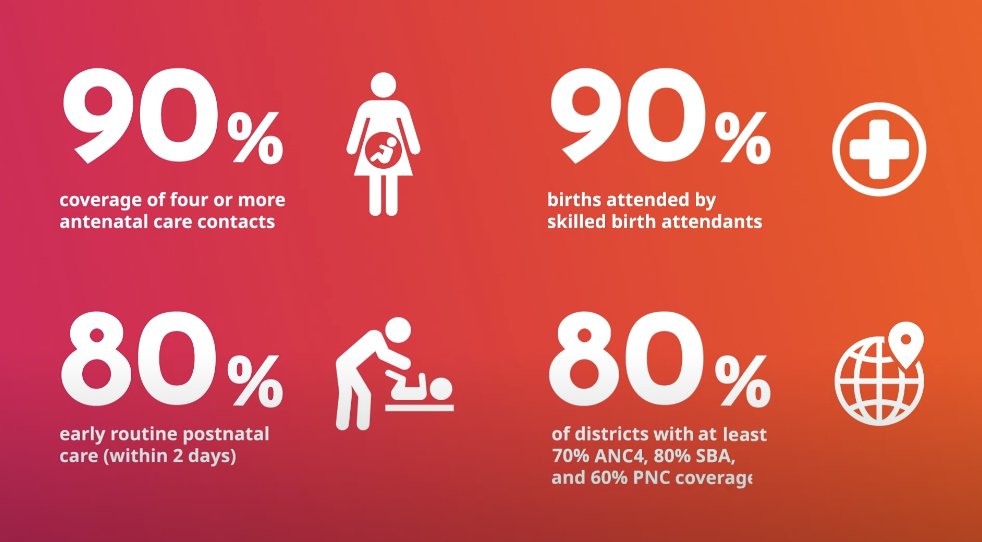Measuring Global Progress
At the global level, MNH targets to date have focused on mortality reduction and service coverage targets but other measures are needed to capture related issues such as coverage and quality of care. Moller et al. provide a history of maternal and newborn health outcome monitoring, documenting global key events and initiatives over recent decades that show how maternal and neonatal mortality and morbidity, and stillbirths, have been viewed, when they have achieved higher priority on the global agenda, and how they have been measured, monitored and reported. Despite substantial improvements, enormous MNH disparities that persist within and between countries indicate an urgent need to focus on reducing inequities. This sub-section summarizes global maternal and newborn health targets including the Sustainable Development Goal (SDG) MNH targets, the Every Newborn Action Plan (ENAP) and Ending Preventable Maternal Mortality (EPMM) targets, in addition to providing examples of comprehensive monitoring frameworks and data on present levels and trends.
Targets
The global community is slowly adopting new targets that incorporate quality of care components in addition to mortality indicators. AlignMNH highlights the following resources that lay out targets for maternal and newborn health progress on both a global and national scale. Although ambitious for countries with high mortality, these goals call for an increased focus on ensuring mothers and babies both survive and thrive. The below infographic displays the 90/90/80/80 targets recap: 90% of pregnant women receive >4 antenatal care contacts; 90% of births attended by skilled health workers; 80% of new moms/babies receive postnatal care within 2 days of birth; 80% of country districts can access emergency obstetric services & SSNC.

Source: Improving maternal and newborn health and survival and reducing stillbirth: progress report 2023
-
Report
Improving maternal and newborn health and survival and reducing stillbirth – Progress report 2023
-
Website
The Sustainable Development Goals (SDGs)
-
Strategy
Global Strategy for Women Children Adolescents Health (2016-2030)
-
Strategy
Ending Preventable Maternal Mortality (EPMM): A Renewed Focus for Improving Maternal and Newborn Health and Wellbeing
-
Guidance
ENAP/Stillbirth Targets – Ending preventable newborn deaths and stillbirths by 2030; Moving faster towards high-quality universal health coverage in 2020–2025
-
Data Dashboard
Every Newborn Action Plan (ENAP) and Ending Preventable Maternal Mortality (EPMM) Dashboard
Monitoring Frameworks
To date, there has not been consensus on a set of core metrics to track progress toward the overall global maternal mortality target, which has made it difficult to systematically monitor maternal health status and programs over time. Although considerable efforts have been made to harmonize indicator recommendations, there are still relatively few indicators shared across key monitoring initiatives and some of those that are shared may have definitional variation. Below is a timeline documenting the development of and discussions on key monitoring frameworks for maternal and newborn health. Additionally, key resources provide guidance on the implementation and scale up of recommended monitoring frameworks.
August 2016
A Monitoring Framework for Ending Preventable Maternal Mortality, 2015-2030: Phase I (Moran et al.)
- Consensus on 12 indicators and 4 priority areas for further indicator development and testing
- Indicators being harmonized with the ENAP core metrics for a joint global MNH monitoring framework
June 2018
Scoping Review of Maternal and Newborn Health Indicators (Moller et al.)
-
Scoping review compiled and synthesized recommend global MNH indicators in order
-
140 existing MNH indicators were identified, making prioritization and coordination challenging
October 2018
-
Consensus of 25 indicators, 4 equity stratifies, and 1 transparency stratifies after considering 118 indicators grouped into the 11 key themes outlined in the EPMM report
October 2021
-
8 candidate indicators relevant to priority recommendations in the EPMM Strategies are presented
-
Research Article
Implementation of the new WHO antenatal care model for a positive pregnancy experience: a monitoring framework
-
Position Paper
Quality of care for Maternal and Newborn- a monitoring framework for network countries
-
Research Article
Scaling up a monitoring and evaluation framework for sexual, reproductive, maternal, newborn, child, and adolescent health services and outcomes in humanitarian settings: A global initiative.
Levels + Trends
Moller et al. reminds us that we still depend on estimates since reliable data are still not collected or made available on a regular or frequent basis in many countries. There is a need for countries and donor agencies to invest in improving routine health management information systems, including improvements to the availability, quality (accuracy), timeliness, analysis and use of these data. These resources provide estimates on current levels and trends and include additional information on relevant policies focused on maternal and newborn health care.
-
Report
Trends in maternal mortality 2000 to 2020: estimates by WHO, UNICEF, UNFPA, World Bank Group and UNDESA/Population Division
-
Research Article
Global, regional, and national levels and trends in maternal mortality between 1990 and 2015, with scenario-based projections to 2030: a systematic analysis by the UN maternal mortality estimation inter-agency group
-
Research Article
Global, regional, and national causes of under-5 mortality in 2000–19: an updated systematic analysis with implications for the Sustainable Development Goals
-
Report
Levels and Trends in Child Mortality Report, 2022
-
Research Article
Global, regional, and national estimates and trends in stillbirths from 2000 to 2019: a systematic assessment
-
Report
Never Forgotten: The situation of stillbirth around the globe
-
Report
Maternal and newborn health in low- and middle-income countries: A brief assessment of mortality, coverage and policies

